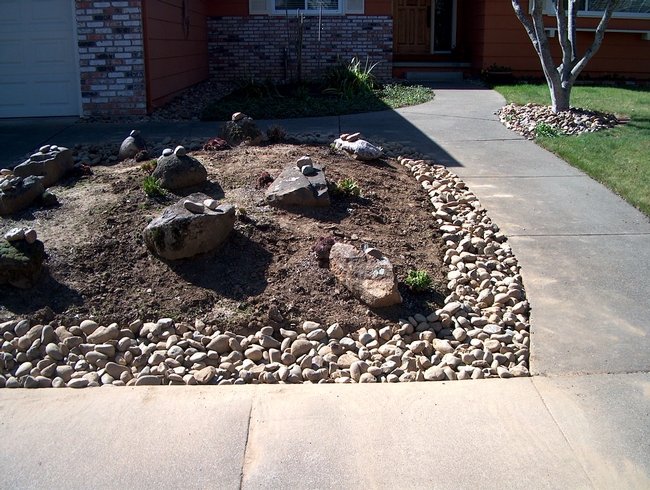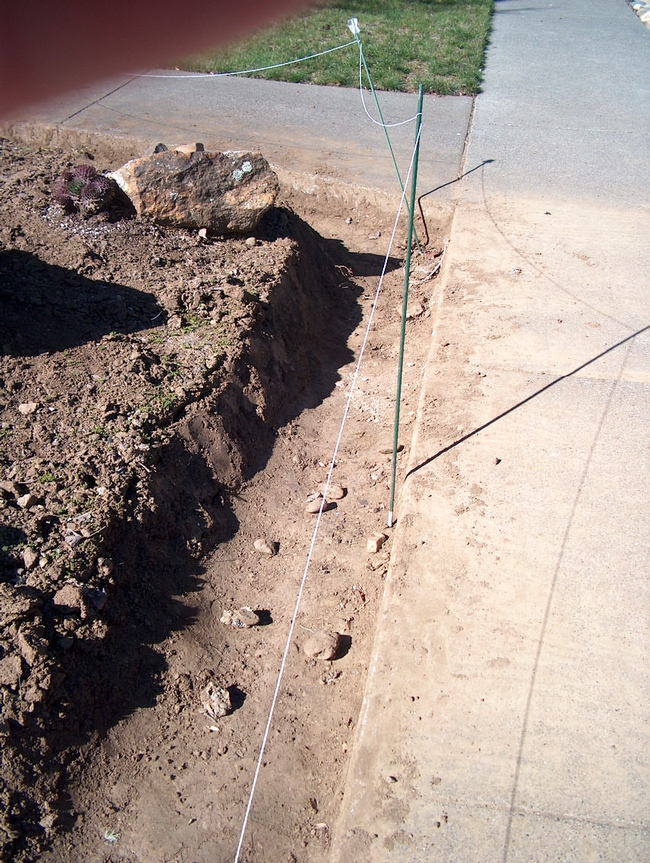
For now, I've turned my energies to creating a rain garden in an area of my yard that tends to produce runoff. In wet weather, this silty water flows onto the sidewalk and then into the street. The plans that I perused required creating a declivity or basin filled with and surrounded by foliage and larger rocks.
The rain garden is not a pond feature; it is actually dry most of the time. It is intended to hold water only briefly during and after a rain, allowing water to filter slowly through the soil and rocks.
People have collected rainwater since ancient times, but the modern rain-garden concept originated in Prince George's County, Maryland, in 1990. By keeping water off the sidewalks and out of the streets,a rain-retention basin reduces the flow of contaminated water into storm drains. It slows the water flow, allowing soil and plants to break down and filter out the pollutants.
Select your location carefully. Look for a natural declivity or a flat place that receives water from a downspout or overland flow during a storm. You can construct a rain garden on a hill but that requires more digging. Avoid locating it over a septic system or near tree roots. Also consider how the nearby landscape plants might adapt to the new watering regime. Finally, avoid underground pipes and pick an area that gets full or partial sun.
Choose a design that complements your existing landscape. Size depends on the collection surface; a 1,000-square-foot rooftop requires at least a 200-square-foot garden. The garden should be able to hold an inch of rain at one time.
In our mediterranean-type climate, we can expect little or no rainfall for at least six months every year. With that in mind, choose native or drought-tolerant plants. Those plants in the basin and the ones on the berm will have different water access so plan accordingly.
You will have to water your plantings for the first year or so, until they get established. Mulch them with a heavy material,such as shredded wood or wood chips, that won't float away during the flooded periods.
The area under consideration in my yard was actually a raised mound. After a rain there was always a mud slick on the sidewalk that filled up the parking strip and then flowed into the street.
The hiccup in my plans was when I realized that I would have to remove and dispose of an astronomical amount of soil. So I had to shelve the rain-garden concept. I solved the runoff problem by digging a two- by two-foot trench around the mound. As it was, I was hard put to find a home for just that amount of soil.
All my garden beds needed freshening, so I mixed the excavated soil with equal amounts of compost and topsoil. With that mixture, I fluffed up my planting beds. I then filled the resulting trench with about six inches of gravel and topped it off with two- by three-inch cobbles that matched the rest of my landscape. I now have created a so-called French drain around the problem location.
Although I am not using the water for irrigation, I hope that percolating the water through the rocks will cleanse it naturally. Based on the meager rains we've had since I completed the work, the water is definitely being re-routed. I no longer see a mud slick on the sidewalk. Instead, the trenches catch the runoff to refill the aquifer.
I was really looking forward to creating a rain garden, but you do the best you can with the situation you have. I planted a succulent garden on the remaining mound, which will help conserve water, and I am quite happy with the result
For more information on creating a rain garden, visit the website of the Watershed Information Center & Conservancy. Also check out the website of California Sea Grant (https://caseagrant.ucsd.edu/sites/default/files/GS3%20Rain%20Gardens_8-10-09.pdf.)
Workshop: Napa County Master Gardeners will lead a workshop on “Drought-Tolerant and California Native Plants” on Saturday, August 1, from 9:30 a.m. to 11:30 a.m., at Martha Walker Garden in Skyline Park in Napa. Enjoy a walk around the garden to observe drought-tolerant and native plants, and discover the elements that help them thrive in our mediterranean climate. Learn how to use them in your own garden to replace some of those water-hungry ornamentals. On-line registration (credit card only) Mail-in registration (cash or check only)
Master Gardeners are volunteers who help the University of California reach the gardening public with home gardening information. Napa County Master Gardeners ( http://ucanr.org/ucmgnapa/) are available to answer gardening questions in person or by phone, Monday, Wednesday and Friday, 9 a.m. to Noon, at the U. C. Cooperative Extension office, 1710 Soscol Avenue, Suite 4, Napa, 707-253-4143, or from outside City of Napa toll-free at 877-279-3065. Or e-mail your garden questions by following the guidelines on our web site. Click on Napa, then on Have Garden Questions? Find us on Facebook under UC Master Gardeners of Napa County.
Attached Images:
